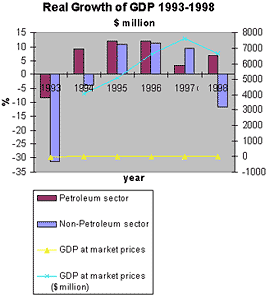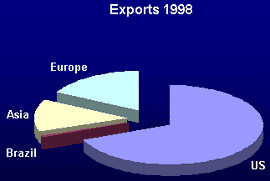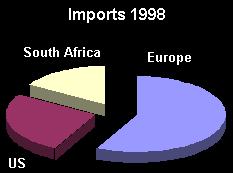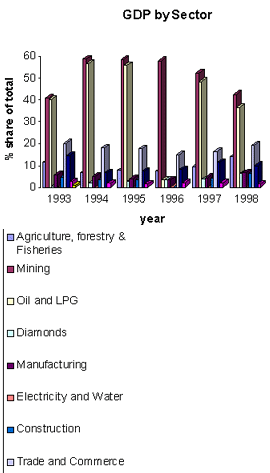 Economy Economy |

The Angolan economy has been dominated by the production of raw materials and the use of cheap labor since European rule began in the sixteenth century. The Portuguese used Angola principally as a source for the thriving slave trade across the Atlantic; Luanda became the greatest slaving port in Africa. After the Portuguese Empire abolished the slave trade in Angola in 1858, it began using concessional agreements, granting exclusive rights to a private company to exploit land, people, and all other resources within a given territory. In Mozambique, this policy spawned a number of companies notorious for their exploitation of local labor. But in Angola, only Diamang, the Diamond Company of Angola showed even moderate success. At the same time, Portuguese began emigrating to Angola to establish farms and plantations (fazendas) to grow cash crops for export. Although these farms were only partially successful before World War II, they formed the basis for the economic growth that shaped Angola's economy in the late 1980s.

Before World War II, the Portuguese government was concerned primarily with keeping its colonies self-sufficient and therefore invested little capital in Angola's local economy. It built no roads until the mid-1920s, and the first railroad, the Benguela Railway, was not completed until 1929. Between 1900 and 1940, only 35,000 Portuguese emigrants settled in Angola, and most worked in commerce in the cities, facilitating trade with Portugal. In the rural areas, Portuguese settlers often found it difficult to make a living because of fluctuating world prices for sugarcane and sisal and the difficulties in obtaining cheap labor to farm their crops. As a result, they often suspended their operations until the market prices rose and instead marketed the produce of Angolan farmers.
But in the wake of World War II, the rapid growth of industrialization worldwide and the parallel requirements for raw materials led Portugal to develop closer ties with its colonies and to begin actively developing the Angolan economy. In the 1930s, Portugal started to develop closer trade ties with its colonies, and by 1940 it absorbed 63 percent of Angolan exports and accounted for 47 percent of Angolan imports, up from 39 percent and 37 percent, respectively, a decade earlier and later developed its infrastructure, by building dams, hydroelectric power stations, and transportation systems. By 1960 the Angolan economy had been completely transformed, boasting a successful commercial agricultural sector, a promising mineral and petroleum production enterprise, and an incipient manufacturing industry.
| 
Yet by 1976, these encouraging developments had been reversed. The economy was in complete disarray in the aftermath of the war of independence and the subsequent internal fighting of the liberation movements. Dozens of bridges had been destroyed, the trading network was disrupted, administrative services did not exist, and files and studies were missing.
Angola's economic ills can also be traced to the legacy of Portuguese colonial development. Although the Angolan economy had started to show strong signs of growth by 1960, most developments had originated recently and precariously. Many of the white settlers had come to Angola after 1950 and were understandably quick to repatriate during the war of independence. During their stay, however, these settlers had appropriated Angolan lands, disrupting local peasant production of cash and subsistence crops. Moreover, Angola's industries depended on trade with Portugal--the colony's overwhelmingly dominant trade partner-- for both markets and machinery. Only the petroleum(link to oil page in BF) and diamond(link to Diamond page in BF) industries boasted a wider clientele for investment and markets. Most important, the Portuguese had not trained Angolans to operate the larger industrial or agricultural enterprises, nor had they actively educated the population. Upon independence Angola thus found itself without markets or expertise to maintain even minimal economic growth.

As a result, the government intervened, nationalizing most businesses and farms abandoned by the Portuguese. It established state farms to continue producing coffee, sugar, and sisal, and it took over the operations of all factories to maintain production. |

